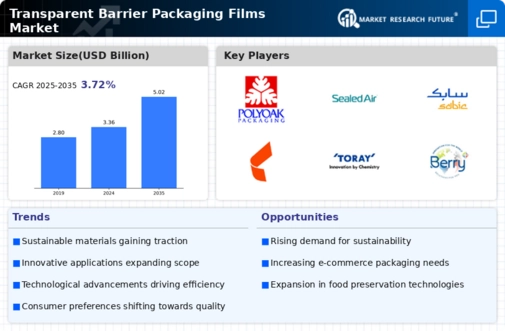Top Industry Leaders in the Transparent Barrier Packaging Films Market

Transparent Barrier Packaging Films Market
The transparent barrier packaging films market is a dynamic and rapidly evolving space, driven by growing consumer demand for sustainable and functional packaging solutions. With its ability to protect food products from spoilage while maintaining visibility, this versatile material has become a mainstay across various industries, from food and beverage to pharmaceuticals and electronics. Understanding the competitive landscape is crucial for businesses operating within this market, and this analysis delves into key strategies, market share factors, industry news, and recent developments.
List of Strategies Adopted by Leading Players:
-
Product Innovation: Leading companies are constantly innovating to develop films with enhanced barrier properties, improved sustainability credentials, and unique functionalities. Examples include Amcor's AmLiner Genesis recyclable pouch film and Treofan's BioPBS biodegradable film. -
Vertical Integration: Integrating upstream and downstream operations allows for greater control over raw materials, production costs, and quality. Bemis Company, for instance, acquired Plastics Packaging Corporation to strengthen its vertical integration in the food packaging segment. -
Geographical Expansion: Expanding into emerging markets with high growth potential is a key strategy for many players. Sealed Air's acquisition of Pachem, a leading Indian packaging company, is a testament to this trend. -
Partnerships and Collaborations: Collaborations with technology providers, research institutions, and brand owners are fostering innovation and accelerating the development of new film solutions. For example, Dow partnered with Mitsubishi Chemical to develop a new high-performance film for food packaging. -
Sustainability Focus: Sustainability is becoming a major differentiator in the market, with companies investing in bio-based materials, recyclable films, and energy-efficient production processes. Mondi's EcoStretch recyclable stretch film is a prime example of this commitment.
Factors Influencing Market Share:
-
Brand Reputation: Established brands with a strong track record of quality and reliability often command higher market share. Amcor, Sealed Air, and Treofan are some of the leading players with significant market share. -
Product Portfolio Diversity: Offering a wide range of films catering to different applications and user needs broadens market reach. Companies like Berry Global and Uflex are known for their diverse product portfolios. -
Cost Competitiveness: Offering competitive pricing without compromising on quality is essential for attracting and retaining customers. Taghleef Industries, for instance, has gained market share through its cost-effective film solutions. -
Geographical Presence: Having a strong presence in key markets with high demand is crucial for growth. Companies like Bemis and Amcor have established global networks to cater to diverse regional needs. -
Innovation and R&D: Continuous investment in research and development helps companies stay ahead of the curve and introduce new, differentiated products. Mitsubishi Chemical's development of a high-barrier, lightweight film is an example of successful R&D efforts.
Prominent Players
Amcor Ltd. (Australia), Bemis Company, Inc. (U.S.), 3M Company (U.S.), Mitsubishi Plastic (Japan), AMPAC (U.S.), Berry Global, Inc. (U.S.), Innovia Films (U.K.), Toppan Printing Co., Ltd. (Japan), Daibochi Plastic & Packaging Industry Bhd (Malaysia), and LINPAC Group (U.K.)
Recent Developments:
August 2023: Amcor announces the launch of its AmLite Ultra R, a recyclable pouch film with enhanced barrier properties for extended shelf life.
September 2023: Sealed Air acquires EcoCor, a leading provider of sustainable packaging solutions, further bolstering its sustainability portfolio.
November 2023: Berry Global unveils its NatureGuard Pro, a recyclable stretch film made from post-consumer recycled content.
December 2023: Uflex expands its production capacity for biaxially oriented polypropylene (BOPP) films to cater to the growing demand in the Asia-Pacific region.

